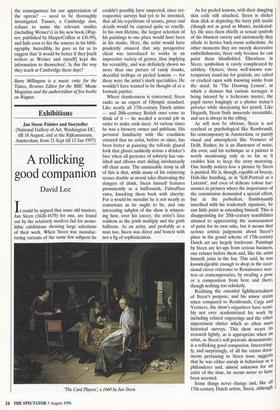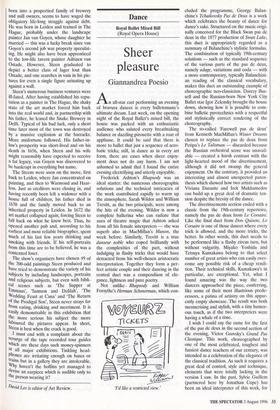Exhibitions
Jan Steen: Painter and Storyteller (National Gallery of Art, Washington DC, till 18 August, and at the Rijksmuseum, Amsterdam, from 21 Sept till 12 Jan 1997)
A rollicking good companion
David Lee
It could be argued that some old masters, Jan Steen (1626-1679) for one, are found out by the relatively modern fad for mono- lithic exhibitions showing large selections of their work. When Steen was manufac- turing variants of the same few subjects he
couldn't possibly have suspected, since ret- rospective surveys had yet to be invented, that all his repetitions of scenes, poses and details would be exposed quite so cruelly. In his own lifetime, the largest selection of his paintings in one place would have been in his studio. Here, the artist would have prudently ensured that any prospective client was introduced to works in an impressive variety of genres, thus implying his versatility, and was definitely shown no more than one picture of randy drunks, deceitful trollops or peeled lemons — for these were the artist's stock specialities. He wouldn't have wanted to be thought of as a formula painter.
Where drunkenness is concerned, Steen ranks as an expert of Olympic standard. Like nearly all 17th-century Dutch artists — and 20th-century British ones come to think of it — he needed a second job in order to make ends meet. At various times he was a brewery owner and publican. His personal familiarity with the condition ensured that no artist, before or since, has been better at painting the tell-tale glazed look that ghosts suddenly across a drinker's face when all pretence of sobriety has van- ished and elbows start sliding involuntarily off chair arms. The unmissable irony in all of this is that, while many of his roistering scenes double as moral tales illustrating the dangers of drink, Steen himself features prominently as a buffoonish, Falstaffian extra, knocking them back with alacrity. For a would-be moralist he is not nearly as censorious as he ought to be, and one interesting subplot of the show is witness- ing how, over his career, the artist's face reddens as the jowls multiply and the girth balloons. As an artist, and probably as a man too, Steen was direct and honest with not a fig of sophistication.
'The Card Players; c.1660 by Jan Steen As for peeled lemons, with their dangling skin coils still attached, Steen is slicker than slick at depicting the furry pith inside (though not as good as Manet, incidental- ly). He uses them chiefly as sexual symbols of the bluntest variety and customarily they allude to furtive back-room seductions. At other moments they are merely decorative embellishments, there only because he can paint them blindfolded, Elsewhere in Steen, symbolism is rarely complicated by subtlety. Oysters, those well-known con- temporary stand-ins for genitals, are salted or cracked open with knowing winks from the maid. In 'The Drawing Lesson', in which a demure but curious teenager is being tutored by a lecherous master, the pupil stares longingly at a plaster statue's privates while sharpening her pencil. Like Hogarth, Steen finds innuendo irresistible, and sex is always in the offing.
As will now be obvious, Steen is not cerebral or psychological like Rembrandt, his contemporary in Amsterdam, or purely visual and atmospheric like Vermeer of Delft. Rather, he is an illustrator of noise, din even, and his technique as a painter is worth mentioning only in so far as it enables him to keep the story motoring. One hardly notices how a picture by Steen is painted. He is, though, capable of breezy, Hals-like handling, as in 'Self-Portrait as a Lutenist', and even of delicate colour har- monies in pictures where the importance of the commission demanded a special effort, but in the potboilers, flamboyantly inscribed with his trademark signature, he saw little point in extending himself. This is disappointing for 20th-century sensibilities attuned to appreciating the sensuousness of paint for its own sake, but it means that serious artistic judgments about Steen's place in the grand scheme of 17th-century Dutch art are largely irrelevant. Paintings by Steen are let-ups from serious business, one relaxes before them and, like the artist himself, joins in the fun. This said, he was knowledgeable enough to drop in the occa- sional clever reference to Renaissance mas- ters or contemporaries, by stealing a pose or a composition from here and there, though nothing too scholarly.
Realising the essential lightheartedness of Steen's purpose, and his minor status when compared to Rembrandt, Cuyp and Vermeer, the show's organisers have sensi- bly not over academicised his work by including related engravings and the other impertinent clutter which so often mars historical surveys. This show wears its research lightly, as is appropriate when an artist, as Steen's self-portraits demonstrate, is a rollicking good companion. Interesting- ly, and surprisingly, of all the extant docu- ments pertaining to Steen none suggests that he was either unruly in behaviour or a philanderer and, almost unknown for an artist of the time, he seems never to have been arrested,
Some things never change and, like all 17th-century Dutch artists, Steen, although born into a propertied family of brewery and mill owners, seems to have waged the obligatory life-long struggle against debt. He was born in Leiden and trained in The Hague, probably under the landscape painter Jan van Goyen, whose daughter he married — this was a lucky break since van Goyen's second job was property speculat- ing. He might also have been apprenticed to the low-life tavern painter Adriaen van Ostade. However, Steen graduated to depict a better class of lager lout than Ostade, and one searches in vain in his pic- tures for even a single figure urinating up against a wall.
Steen's numerous business ventures were ill-fated. After having established his repu- tation as a painter in The Hague, the shaky state of the art market forced him back into the real world and, in partnership with his father, he leased the Snake Brewery in Delft. Typical of his bad luck, only a short time later most of the town was destroyed by a massive explosion at the barracks. More misfortune followed. His father-in- law's prosperity was short-lived and on his death in 1656, when Steen and his wife might reasonably have expected to receive a fat legacy, van Goyen was discovered to be bankrupt in everything but name.
The Steens were soon on the move, first back to Leiden, where Jan concentrated on Painting, and then to Warmond and Haar- lem. Just as creditors were closing in, and having recently been left a widower with a house full of children, his father died in 1670 and the family moved back to an inherited property in Leiden. In 1672 the art market collapsed again, forcing Steen to fall back on what he knew best. Thus, he opened another pub and, according to his earliest and most reliable biographer, spent much of his last few years drinking and smoking with friends. If his self-portraits from this time are to be believed, he was a contented loser.
The show's organisers have chosen 49 of the 700-odd paintings Steen produced and have tried to demonstrate the variety of his subjects by including landscapes, portraits and religious subjects, but even with bibli- cal scenes such as 'The Supper at Emmaus', 'Samson and Delilah', 'The Wedding Feast at Cana' and 'The Return of the Prodigal Son', Steen never strays far from eating, drinking and merriment. It is easily demonstrable in this exhibition that the more serious his subject the more laboured the pictures appear. In short, Steen is best when the crack is good. I must end with a complaint about the scourge of the tape recorded tour guides which are these days such money-spinners at all major exhibitions. Tinkling head- Phones are irritating enough on buses or trains but in a gallery they are intolerable. Why haven't the boffins yet managed to devise an earpiece which is audible only to the person wearing it?
David Lee is editor of Art Review.



















































 Previous page
Previous page